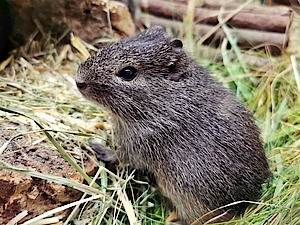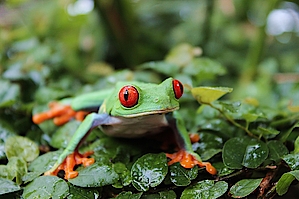ANIMALS IN THE TROPICAL WORLD
It rustles in-between the trees, in the bushes, birds are chirping and fly from twig to twig. A lizard slowly moves from stone to stone and rests there. Ducks and turtles live together in a lake and compete in swimming.
In the Biosphäre Potsdam you can experience many different animals, many of them in authentically designed terrariums and aquariums.
You can also discover many small animals in-between the bushes.
This is a small selection of all animals living in the Biosphere.
Common Marmosets

Common Marmoset (Callithrix jacchus) are relatively small primates and live in the trees of the rainforests of Brazil, where they like to venture high. With an eight-meter-high tower, we give visitors the opportunity to watch them in their compound while skilful and nimble climbing.
The marmosets nutrition in the wild mainly consist of many fruits, insects and tree sap. With us, too, their diet is very varied - however, visitors should refrain from feeding, because this can make the animals sick.
The monkeys live together in groups of two to fifteen animals and communicate with each other through facial expressions, postures and various sounds such as clicking and chirping. Monkey couples usually live monogamous, but only the oldest pair within a group reproduces.
Experience our active acrobats at the weekly animal feedings.
Wild guinea pigs

The tropical relatives of the house guinea pig originally come from South America. A family of wild guinea pigs lives at the end of the Höhenweg in the tropical hall of the Potsdam Biosphere. The visitors enjoy watching the cute little animals up close and discovering some of the illustrious peculiarities of the guinea pigs. The furry rodents, for example, have a habit of jumping in the air with all feet at the same time when excited. The pigs can hop up to 50 cm high. Often they are compared to popcorn, which is jumping up and rising on the hot stove. This is why the fun jumping around is also called "popcorn". Young animals in particular are often seen doing this hobby.
Green Iguana

Don’t get confused! Unlike its name suggests, the Green Iguana (Iquana iquana) is not always green, but sometimes brownish or, like some males, even orange-red in color.
Characteristic of the diurnal tree dweller is its throat-dew, a scaly skin flap below the mouth, which serves both the thermoregulation and the communication with conspecifics. The heavily perfused skin fold cools him on warm days or warms him on cold days. For this purpose, the green iguana turns towards the sun and inflates the throat sack. A similar behavior can be observed when two male iguanas get in each other's way. However, here the puffiness shows dominance. Instead of fighting, the male with the bigger throat bag wins.
Veiled chameleon
The veiled chameleon can also be called the Yemen chameleon, because it is very common in the south of the Arabian peninsula, especially in Yemen.
The chameleon (Chamaeleo calyptratus) can become as long as 50 centimeters and therefore belongs to one of the larger species.
One of the characteristics of this chameleon is its changing color. The changing color has less to do with its surroundings but is influenced by its emotions. For example gravid chameleons are dark green with blue and yellow spots.
The common clownfish
The ocellaris clownfish is a rather bad swimmer, that’s why it uses anemones to hide from predators. Anemones protect the clownfish with their cnidocyte in their tentacles. At the same time, the clownfish protects the anemone from specialized predators. The anemone and clownfish engage in symbiosis – this is why the genus, to which the clownfish belongs, is called amphiprion.
Common Morpho
The Blue Morpho Butterfly (Morpho peleides) reminds with its beautiful color of the blue sky. These dazzling colors are created by tiny scales on the wings, which reflects only the blue light. In contrast to the conspicuous wing top, the underside is in a rather simple brown with yellowish eyes. When it flies through the air, you can see the bright blue flash every now and then.
Walking leaves
Walking leaves (Phyllium giganteum) are masters of camouflage. They can hardly be distinguished from a normal leaf. When in danger the walking leaf starts shaking like a leaf in the wind and therefore becomes almost invisible for their predators.
Biologists call this mimicry.
Even in the terrariums of the Biosphere you need to look closely to discover them.
Superb starling
Our local starlings are known for their complex vocalizations and their ability to imitate various sounds - even cell phone tones. Like its native relatives, the superb starling (Lamprotornis superbus) is characterized by its complex vocalizations and ability to imitate. By imitating warning calls, the smart forest dweller succeeds in irritating its competitors and thus securing important food resources.
Surgeonfish
From the family of the surgeonfish (Acanthuridae) especially the blue yellow palette surgeonfish (Paracanthurus hepatus) is very well known. This family includes many other genera and thus covers a wide range of colors: from bright yellow to orange-blue striped to plain gray. These fish owe their comparison with surgeons because of a razor-sharp scalpel-like spine on her tail root. They use this for defense, but can also use it for attack. However the peaceful animals attack very rarely.
Red-eyed tree frog
The eponymous eye color of the red-eyed tree frog (Agalychnis callidryas) can be easily overlooked at first. Since the animals are nocturnal, one gets to see them during the day more in the sleeping state and in this their eyes appear through the semi-transparent closed eyelids rather golden. When the frog awakens, the lid folds back and the red eyes are visible. The tree frog sheds every night and only then goes in search for food.
Python regius

Even though the name (royal python) is suggesting something else, the python regius with its approximate length of 1.2 m is one of the smallest species of python.
The name possibly refers to the time, when some African rulers wore the python as jewelry on the head. If in danger the python coils up into a ball and hides it head – this is why it is sometimes called a ball python!
Due to its adaptability, it does not only live in the tropical rain forests but also in savannahs of west and east Africa and occasionally gets close to men.








